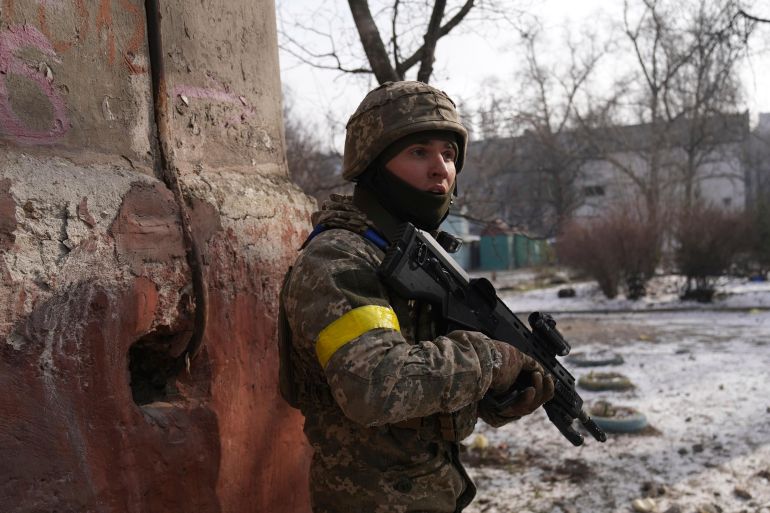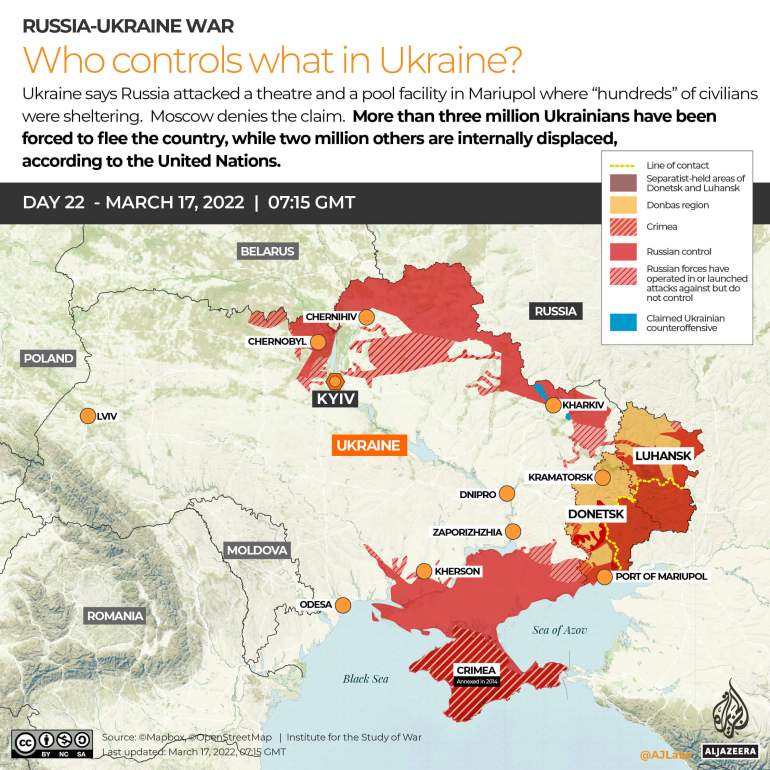Where is the Russia-Ukraine war heading? Five scenarios
As Russia’s invasion enters its fourth week and fighting intensifies, how might the situation develop from here?

Russia’s war on Ukraine has entered a fourth week, as increasingly harsh rhetoric from Western powers towards Russian President Vladimir Putin fails to stop attacks in several cities.
It is near impossible to verify how many civilians have been killed so far. According to the United Nations, more than 600 have died – but the real figure is feared to be higher.
Keep reading
list of 4 itemsPhotos: Russian bombing leaves Ukraine’s Kharkiv in ruins
Ukraine war’s rising cost for daily Russian lives
How does Russia’s invasion of Ukraine impact the Middle East?
Reports say thousands of soldiers on both sides have also died.
Meanwhile, Russia-Ukraine talks aiming for a peaceful solution continue as reports grow of Russia’s military becoming bogged down.
How might the situation develop from here? Here are five scenarios:
Military quagmire
Ukrainian forces are still resisting Russia’s invasion, inflicting serious equipment and human losses.
Crucially, they repelled an attempt by paratroopers to seize the capital Kyiv in the opening days of the conflict and have since withdrawn to defensive positions that have enabled them to keep control over all strategic cities.
Although Russia has long claimed it has air superiority, Ukraine’s air defences appear to be still working, while Western countries are pouring in portable anti-tank and anti-aircraft missiles.
“The Russian invasion has largely stalled on all fronts,” an update from the UK defence ministry said on Thursday.
But in an interview with Al Jazeera, Frank Ledwidge, senior lecturer in military capabilities and strategy at the University of Portsmouth, said “What’s happened here is that the Russian attack has, in military terms, culminated”.
“They’ve gone as far as they can with the logistics and weaponry they brought into the country – that doesn’t necessarily mean it’s stalled,” he said.
“What we’re seeing now is what’s called an operational pause as they start to get, in colloquial terms, their act together, which they have not had largely due to very poor planning assumptions in the early part of the campaign.
“So they’d be working frantically to try to get weapons and get their planning sorted out and to understand where does it go next. And of course, Ukrainians have a say in that, which is why we are starting to see counterattacks by Ukrainian armed forces that seem to be having some effect.”
United States intelligence estimates that 7,000 Russian troops have died, The New York Times reported – although experts say that all such claims should be treated with caution.
US President Joe Biden announced a massive new package of military aid for Ukraine on Wednesday, including 100 Switchblade “kamikaze” drones and thousands more missiles.
Ukrainian military resistance comes at a high civilian cost, however, with thousands dead and towns devastated such as Mariupol and Kherson.

Peace deal agreed
Negotiators from both sides began talking just days after the war started, first on the Belarus-Ukraine border, then in Turkey and later in Kyiv.
Mounting battlefield losses and crippling Western sanctions on the Russian economy could be pushing Putin to seek a face-saving way to end the conflict.
“Ukraine may be able to compel the Russians to make a choice: to persist and suffer irreparable losses, or desist and achieve some compensatory peace,” AFP news agency quoted Rob Johnson, a warfare expert at the University of Oxford, as writing this week.
Russian Foreign Minister Sergey Lavrov said on Wednesday that the two sides were “close to agreeing” on a deal that would see Ukraine accept neutrality modelled on the status of Sweden and Austria.
Ukrainian President Volodymyr Zelenskyy has already publicly acknowledged that his country will not join the Western NATO military alliance – a key demand from the Kremlin.
But though the chances of a deal have grown significantly in recent days, there is no sign of a ceasefire and Ukraine wants a full Russian withdrawal and security guarantees about its future.
Some Putin critics suspect that the diplomacy is a smokescreen.
“Reminder that to Putin ‘ceasefire’ just means ‘reload’,” dissident Russian politician and former chess champion Garry Kasparov wrote on Twitter.
Putin deposed
Putin is tightening his grip over Russian society. A crackdown on independent media and foreign news providers has cemented the dominance of the ultra-loyal Russian state media.
Thousands of anti-war demonstrators have been arrested, while a new law threatens up to 15 years in jail for spreading “fake news” about the army.
There are signs of cracks in the ruling elite, with some oligarchs, MPs, and even private oil group Lukoil calling openly for a ceasefire or an end to the fighting.
A Russian editor held up a sign saying “No War” during a prime-time news broadcast on state TV this week.
Though not seen as likely at this stage, the possibility of Putin being brought down in a popular backlash or even a palace coup cannot be ruled out.
“His personal security is very good and it will be very good until the moment it isn’t,” said Eliot A Cohen from the Center for Strategic and International Studies, a Washington-based think-tank.
“That’s happened numerous times in Soviet and Russian history.”
Russian military success
Given Russia’s superior weapons, air power and indiscriminate use of artillery, Western defence analysts say its forces are capable of grinding forward.
A senior European military official cautioned on Wednesday against underestimating their ability to replenish and adapt their tactics.
They appear to have logistical and morale problems, with diesel and even engine lubricants in short supply, the official said.
“But you need to keep it in perspective. All of that does not change the superiority of the Russian military,” he said.
Moscow is openly recruiting mercenaries from Syria to supplement its forces, while also using the Wagner Group, a shadowy Russian private security company.
But even if they captured strategic cities such as Kyiv or the southern port of Odesa, Putin would then face the challenge of occupying them.
Conflict spreads
Russia has a border with three former Soviet states that are now members of the US-led NATO military alliance, which considers an attack on one member to be an attack against all.
Putin’s nostalgia for the Soviet Union and his pledge to protect Russian minorities – who are found in the Baltic States – has left an open question about his territorial ambitions.
Few expect Putin to openly attack a NATO member, which would run the risk of a nuclear attack, but analysts have warned about provocations that stop short of sparking a war.
Putin has ordered Russia’s nuclear deterrent forces onto high alert and Foreign Minister Lavrov has also warned that “World War III can only be a nuclear war”.
Western analysts say such warnings should be taken as posturing to deter the US and Europe from considering ideas such as a “no-fly zone” over Ukraine.